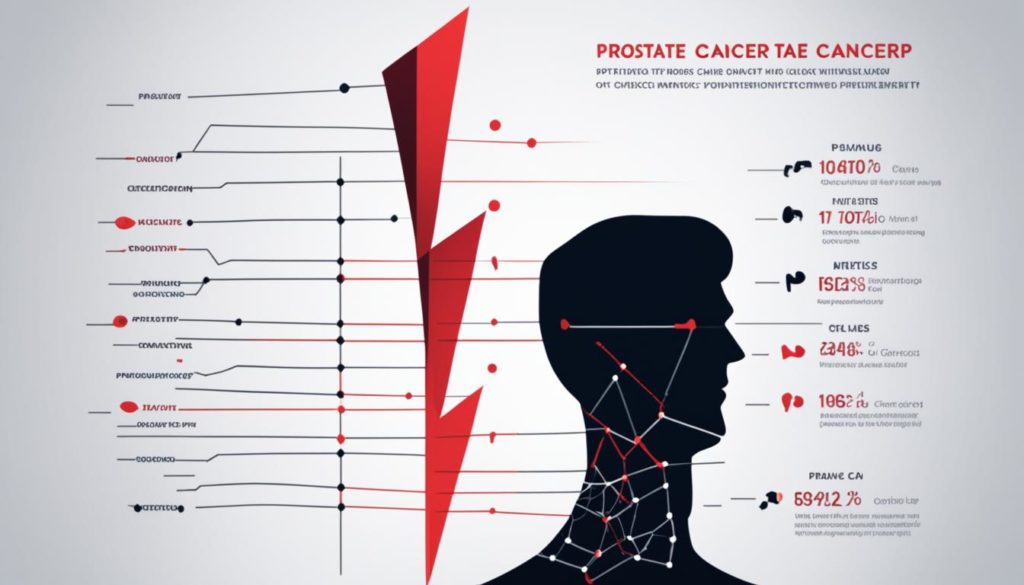Did you know prostate cancer is a big deal in the U.S., with nearly 200,000 new cases each year? It’s the second-leading cause of cancer death for American men. Yet, many myths and misconceptions surround this health issue. It’s often seen as an “old man’s disease” and there’s confusion about PSA tests.
Groups like the Dana-Farber Cancer Institute are fighting these myths with facts. They provide clear information about prostate cancer. This article will clear up common myths, offer important insights, and push for better education on prostate cancer.
Key Takeaways
- Prostate cancer is the second-leading cause of cancer death among U.S. men.
- Misconceptions about prostate cancer can hinder effective detection and treatment.
- Age-related myths and PSA test misunderstandings are common yet incorrect.
- Evidence-based information from trusted sources like Dana-Farber Cancer Institute is vital.
- Comprehensive prostate cancer education helps in making informed health choices.
Prostate Cancer Only Affects Older Men
Many people think Prostate Cancer Misconceptions that it only hits older men. While age is a big risk factor, younger men can still get it. It’s important to know the risks for everyone, no matter their age.
Age-Related Risk Factors
Age is a big factor in getting prostate cancer. Most cases are found in men over 65. This is due to many things, like being exposed to harmful substances over time and the aging process.
But, thinking young men don’t have to worry is a dangerous Prostate Cancer Misconception.

Incidence in Younger Men
Younger men can also get prostate cancer. Studies have found cancer in young people who died from other causes. This shows that the disease can be there even if you’re young.
This Prostate Cancer Information tells us to be careful and aware. It’s key to know which cancers need treatment and which ones don’t.
Asymptomatic Nature of Prostate Cancer
Prostate cancer often doesn’t show symptoms early on, making it hard to catch it early. This fact shows how important it is for men to keep an eye on their health, even if they feel great.

Common Symptoms to Watch For
Even so, some signs might suggest prostate cancer is there:
- Urinary issues, like a weak flow or needing to go often
- Blood in urine or semen
- Difficulty getting an erection
- Pain in the pelvic area
- Painful ejaculation
It’s important to know these symptoms can also mean other health issues, making it harder to spot prostate cancer.
Importance of Routine Checkups
Since prostate cancer can quietly progress, regular check-ups are key. Getting screened for prostate cancer can catch it early, when it’s easier to treat. Talking to health experts regularly helps clear up the idea that symptoms are needed to know if you have prostate cancer.
Adding prostate cancer screening to your health routine can lead to finding it early and treating it well. This can greatly improve your chances of beating the disease and living longer.
Prostate Cancer is Always Slow Growing
This idea that all prostate cancers grow slowly and don’t need quick action is wrong. In reality, prostate cancer can be fast-growing and require different treatments based on each case.
Understanding Cancer Aggressiveness
How aggressive prostate cancer is can vary a lot from one person to another. Doctors look at things like Gleason score and PSA levels from biopsies to figure out how severe it might be. This helps decide the best treatment. So, not all prostate cancers are the same, which is important to know when thinking about Prostate Cancer Debunked and treatment.
Types of Prostate Cancer
There are different kinds of prostate cancer, each with its own traits and outcomes. The main types are:
- Adenocarcinoma: This is the most common type, making up about 95% of cases.
- Neuroendocrine tumors: These are rare and can be very aggressive, needing strong treatment.
- Small cell carcinoma: This type is also rare but very aggressive.
Knowing these differences is key to understanding Prostate Cancer Debunked. While some types may grow slowly and aren’t a big immediate threat, others can be much more aggressive. This means some need quick and thorough treatment. It’s important to get a detailed look and a treatment plan that fits the individual.
| Type of Prostate Cancer | Common Features | Treatment Notes |
|---|---|---|
| Adenocarcinoma | Most common, usually grows slowly | Often watched closely or treated with hormones and surgery |
| Neuroendocrine | Very rare, very aggressive | Needs strong treatment, often chemotherapy |
| Small Cell Carcinoma | High-grade, spreads quickly | Requires intense chemotherapy and might need radiation |
Knowing about these types and their Prostate Cancer Aggressiveness shows why it’s important to have specific medical plans and to be careful with prostate cancer care.
Family History Does Not Affect Prostate Cancer Risk
Many think not having a family history of prostate cancer means they won’t get it. But, the truth is, prostate cancer hits 1 in 9 American men, family history or not. This shows we all need to learn more about Prostate Cancer Education.
Having a family history does make getting prostate cancer more likely. This is especially true if family members got it young or if many got it. But, not having a family history doesn’t mean you’re safe.
It’s important to know about Prostate Cancer Education. Even men without a family history should watch their prostate health. Knowing this can help catch cancer early and treat it better.
| Risk Factor | Impact on Prostate Cancer Risk |
|---|---|
| Family History of Prostate Cancer | Increases Risk, Especially with Early Diagnosis in Relatives |
| No Family History | No Significant Reduction in Risk |
| Age | Higher Risk as Men Age |
| Ethnicity | Higher Incidence in African-American Men |
We need a full approach to Prostate Cancer Education. It should cover all Prostate Cancer Risk Factors. Men should know their risk, family history or not. Taking steps like regular doctor visits can help fight this common disease.
The PSA Test is Definitive for Prostate Cancer
The idea that a high PSA level means you definitely have cancer is not true. The Prostate Cancer Test checks PSA levels in your blood. These levels can be high for many reasons, not just cancer. This means you might need more tests, like biopsies, to be sure about Prostate Cancer Evidence.
It’s important to understand PSA levels well for correct diagnosis. The Prostate Cancer Test is helpful, but it’s not enough on its own. Here’s a look at what affects PSA levels:
| Condition | Effect on PSA Levels | Additional Diagnostic Steps |
|---|---|---|
| Benign Prostatic Hyperplasia (BPH) | Elevated | Ultrasound, MRI |
| Prostatitis | Elevated | Urine Tests, Culture |
| Prostate Cancer | Elevated | Biopsy, MRI |
High PSA levels don’t automatically mean you have prostate cancer. The Prostate Cancer Test is just the first step. It often points to cases needing more tests to confirm the diagnosis.
Vasectomy and Prostate Cancer Risk
Research on vasectomy and prostate cancer has been ongoing and has sparked debate. Early studies hinted at a link, causing worry for men thinking about vasectomy. But recent findings have shed new light on the topic.
Research on Vasectomy and Cancer
Initial studies pointed to a possible link between vasectomy and prostate cancer, causing alarm. These studies were often flawed, lacking strong controls and overlooking other risk factors. Now, more thorough research has been done to look at the link between vasectomy and prostate cancer risk. These studies consider many factors and use larger, more varied groups of people.
Current Scientific Consensus
Today, experts have a different view. Institutions like the Mayo Clinic say there’s no proof that vasectomy raises prostate cancer risk. This update helps clear up the *prostate cancer myths* that spread before. Yet, experts say research is still needed. They want to look into all possible factors and long-term effects before making final conclusions.
Diet and Prostate Cancer
Understanding how diet affects prostate cancer is key to preventing it. What we eat can change our risk and how the cancer grows.
Flaxseeds and Prostate Cancer
Flaxseeds are full of phytoestrogens called lignans. They might help lower PSA levels, which is a sign of prostate cancer getting worse. Eating flaxseeds could protect against prostate cancer, but we need more proof.
Pomegranate Juice and Prostate Cancer
Pomegranate juice is also seen as a possible help in fighting prostate cancer. It’s packed with antioxidants. Studies show it might slow down cancer growth and help prevent it. But, we need more studies to be sure it works.
| Nutritional Element | Benefits | Current Research Status |
|---|---|---|
| Flaxseeds | May lower PSA levels | Needs further validation |
| Pomegranate Juice | Potential to reduce tumor aggressiveness | Requires more robust evidence |
Prostate Cancer Myths vs Facts
It’s key to know the truth about prostate cancer for the right diagnosis and treatment. By clearing up common myths, we help those affected and support smart health choices. Knowing the facts about prostate cancer is vital to fight wrong info and make sure people get the right screenings and treatments.
Common Prostate Cancer Misconceptions
Many myths about prostate cancer cause confusion and worry. These myths often deal with who’s at risk, how it’s found, and what symptoms to watch for. By tackling these myths, people can better understand the truth about prostate cancer.
- Myth: Only older males get prostate cancer.
Fact: Age is a risk factor, but younger men can get it too. - Myth: Prostate cancer always has clear symptoms.
Fact: Many times, there are no symptoms, so regular check-ups are key. - Myth: A high PSA level always means cancer.
Fact: High PSA can be due to many things, not just cancer.
Evidence-Based Information
Using facts backed by science helps fight prostate cancer myths. Studies show that catching it early through regular tests, even if you feel fine, can really improve treatment results. This shows why it’s crucial to trust credible sources when making health choices.
| Myth | Reality |
|---|---|
| Prostate cancer is always slow-growing. | Not true; some prostate cancers grow fast and can be severe. |
| Family history does not affect risk. | Having a family history of prostate cancer raises your risk. |
| Vasectomy increases prostate cancer risk. | Many studies have found no link between vasectomy and higher risk. |
By knowing the truth about prostate cancer and debunking myths, we can help men get the right medical care. They can use the latest research to manage their health better.
Enlarged Prostate Means Prostate Cancer
A common Prostate Cancer Misconceptions is thinking an enlarged prostate means you have cancer. But, an enlarged prostate, known as Benign Prostatic Hyperplasia (BPH), is not cancer. It’s a condition that grows but doesn’t turn into cancer.
Benign Prostatic Hyperplasia and prostate cancer share some symptoms like trouble with urination. But having BPH doesn’t make you more likely to get prostate cancer. Men with urinary problems should see a doctor to get the right diagnosis and treatment.
Let’s look at the symptoms and what they might mean:
- Benign Prostatic Hyperplasia: Includes frequent urination, trouble starting to urinate, and a weak urine stream.
- Prostate Cancer: Can also cause similar symptoms, but it needs special tests like biopsies to confirm.
Knowing about Prostate Cancer Misconceptions helps us tell BPH apart from prostate cancer. This way, men get the right medical advice and don’t worry too much.
Prostate Cancer Screening Controversies
Prostate cancer screening, especially the PSA test, is a hot topic among doctors and patients. Early detection can help improve treatment results. But, there are worries about over-diagnosis and treatments that aren’t needed.
Experts say it’s key to have screening plans that fit each person. The Prostate Cancer Guidelines suggest talking with doctors about PSA screening. This helps patients know the good and bad of different tests.
PSA Test Debate
The debate over the PSA test is about its benefits and risks. Supporters say it finds cancer early, which is crucial for effective treatment. But, critics worry it might cause too many false positives, leading to unnecessary worry and treatments.
Screening Recommendations
Screening advice varies with each person’s risk level. Prostate Cancer Guidelines suggest considering age, family history, and health before screening. Talking with doctors is key to making a smart choice about prostate cancer screening.
| Screening Criteria | Recommendation |
|---|---|
| Age 40-54 | Discuss risks and benefits based on family history and personal health. |
| Age 55-69 | Personalized decision after discussing potential outcomes with a healthcare provider. |
| Age 70+ | Screen selectively based on overall health and potential life expectancy. |
The debate on prostate cancer screening shows we need care tailored to each patient. This ensures everyone gets the best advice for their health.
Conclusion
It’s crucial to understand and clear up wrong ideas about prostate cancer for good health. This piece aimed to give the right info by debunking common myths. We talked about how age, family history, and diet affect prostate cancer risk. We also looked at how the disease can be silent and how different cancers act differently.
Wrong info can make people worry too much or feel safe when they shouldn’t. It’s key to trust facts backed by science and medical proof. Regular tests, even if some debate them, help catch cancer early. By being proactive and talking well with doctors, people can handle prostate cancer better.
In wrapping up this deep look into prostate cancer, staying informed and active is key. Talking openly with doctors helps get the best care early. Always choose facts over myths, and make health choices based on proven truths about prostate cancer.
FAQ
Does prostate cancer only affect older men?
Most prostate cancer cases are found in men over 65. But, younger men can get it too. Studies show that some young people may have prostate cancer without it causing problems. So, age is a big risk factor, but not the only one.
Are there symptoms that indicate prostate cancer?
Many times, prostate cancer doesn’t show symptoms. But, some signs like trouble with urination or painful ejaculation might hint at it. These signs can also come from other health issues. So, it’s key to get regular check-ups to catch it early.
Is it true that all prostate cancers are slow-growing?
Not all prostate cancers grow slowly. They can vary in how fast they spread. Some types need quick action based on tests and the patient’s health and age.
Does family history affect the risk of developing prostate cancer?
Yes, a family history of prostate cancer raises the risk. But, 1 in 9 American men will get prostate cancer, with or without a family history. The risk goes up if cancer hits early or affects many family members.
Is the PSA test a definitive measure for diagnosing prostate cancer?
No, a high PSA level doesn’t mean you definitely have prostate cancer. It can also be from other issues like an enlarged prostate or infection. You’ll need more tests, like biopsies, to be sure.
Does a vasectomy increase the risk of prostate cancer?
Studies on this topic have given mixed answers. But, most experts, like the Mayo Clinic, say there’s no strong link between vasectomy and prostate cancer. We need more research to understand this better.
Can diet impact the risk or treatment of prostate cancer?
Some foods like flaxseeds and pomegranate juice might help with prostate cancer. Early studies looked promising. But, we need more proof to say for sure how they help or hurt.
Are there common misconceptions about prostate cancer?
Many people think they know the risks, tests, and signs of prostate cancer. But, facts are key to teach men about screening and their own risks.
Does an enlarged prostate (BPH) mean I have prostate cancer?
No, BPH and prostate cancer are not the same. BPH doesn’t raise your chance of getting prostate cancer. But, they can have similar symptoms. So, seeing a doctor is important to know for sure.
Why is there controversy surrounding prostate cancer screening?
The PSA test debate is about over-diagnosis. Doctors suggest talking with your doctor about PSA screening. They look at your health and risk factors to decide if screening is right for you.


